About Railroadiana
Many people are fascinated by railroads. At one time, railroads were
connected to most aspects of community and economic life, and almost
everyone had the experience of taking the train to some distant destination.
Today, railroads are still a vital part of the nation's commerce, but
they have largely evolved into less publicly visible movers of freight.
For the most part, the romance and glory of the great age of railroads
has passed from the scene.
One way of remembering this bygone era is through collecting artifacts
that have survived the years. Most railroad lines were (and are) large
enterprises requiring vast amounts of material and equipment to operate.
While much of this material and equipment like locomotives, cars, buildings,
etc. are "collectible" for only a small number of people and
organizations with the resources to maintain them, smaller items like
lanterns, china, paper, and locks are well within the reach of individual
collectors. Therefore, many people seek out such items -- often called "railroadiana" --
at auctions, garage sales, antique shows and "collector events".
There is no standardized set of categories for railroadiana. In fact,
the items associated with railroads are vast and almost defy classification.
However, here are some of the more popular types of items that railroadiana
collectors have in their collections.
China
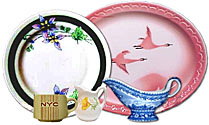 During
the grand era of passenger train travel and extending to the 1960's,
railroads made an effort to attract business by making travel an enjoyable
and even elegant experience. For long distance runs in particular, a
major part of this experience was dining. Consider that a cross-country
trip might take several days by train, and this added up to quite a
few meals taken en route. To make dining cars like fine restaurants,
railroads gave a lot of attention to the china that was used. Often
custom patterns were employed with the railroad's name or logo incorporated
into the design or at least marked somewhere on the piece. Nowadays
collectors prize this china, and it has become one of the most popular
categories of railroad collectibles. During
the grand era of passenger train travel and extending to the 1960's,
railroads made an effort to attract business by making travel an enjoyable
and even elegant experience. For long distance runs in particular, a
major part of this experience was dining. Consider that a cross-country
trip might take several days by train, and this added up to quite a
few meals taken en route. To make dining cars like fine restaurants,
railroads gave a lot of attention to the china that was used. Often
custom patterns were employed with the railroad's name or logo incorporated
into the design or at least marked somewhere on the piece. Nowadays
collectors prize this china, and it has become one of the most popular
categories of railroad collectibles.
Within any given pattern of railroad china, a variety of different
types of pieces may have been produced. These include plates, saucers,
coffee cups, demitasse cups, compotes, teapots, chocolate pots, butter
pats, egg cups, bouillon cups, ashtrays, and others. Within any category
such as plates or teapots, there may be different sizes, manufacturers,
and slight variations in the pattern. Like lanterns, china that is explicitly
marked for a railroad, either "top-marked" or "back-stamped",
is especially valued. This distinction takes on special importance in
light of the fact that some railroads used stock patterns that did not
have an explicit railroad marking. Therefore a particular piece may
exhibit the characteristics of a particular pattern, but there is no
guarantee that it ever saw railroad service -- it may have been used
in a hotel for example. Experienced china collectors buy carefully and
are especially wary of unmarked pieces.
Hollowware and Flatware
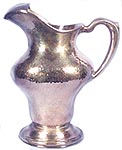 To
accompany the china used in dining car place settings, various types
of hollowware such as teapots, pitchers, and tureens as well as flatware
(spoons, forks, knives, etc.) were used by railroads. These were usually
silver-plated, heavy, and of high quality. Ornate and elaborate designs
were often used to ornament these items, reflecting the tastes of the
era. Railroads tended to adopt particular patterns of hollowware and
flatware, so that today's collectors associate particular patterns with
particular railroads. As with other company items, railroads tended
to mark their hollowware and flatware with initials or logos. [photo
by Tammy Manheim] To
accompany the china used in dining car place settings, various types
of hollowware such as teapots, pitchers, and tureens as well as flatware
(spoons, forks, knives, etc.) were used by railroads. These were usually
silver-plated, heavy, and of high quality. Ornate and elaborate designs
were often used to ornament these items, reflecting the tastes of the
era. Railroads tended to adopt particular patterns of hollowware and
flatware, so that today's collectors associate particular patterns with
particular railroads. As with other company items, railroads tended
to mark their hollowware and flatware with initials or logos. [photo
by Tammy Manheim]
Lanterns and Lamps
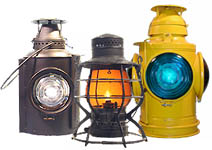 Lighting
devices of many kinds were used on the railroads. The two major categories
of railroad lighting are lanterns and lamps, distinguished mainly by
their construction. Most lanterns are essentially a metal "cage" containing
a transparent or translucent globe that protects an interior light source. Lamps
are essentially a solid metal cylinder with one or more lenses used
to transmit light from an interior light source. This general distinction
does not cover the more modern, electric lanterns which are essentially
a battery container with an exposed light bulb. Lighting
devices of many kinds were used on the railroads. The two major categories
of railroad lighting are lanterns and lamps, distinguished mainly by
their construction. Most lanterns are essentially a metal "cage" containing
a transparent or translucent globe that protects an interior light source. Lamps
are essentially a solid metal cylinder with one or more lenses used
to transmit light from an interior light source. This general distinction
does not cover the more modern, electric lanterns which are essentially
a battery container with an exposed light bulb.
For railroad crews of yesterday, lanterns were an essential tool of
the trade for relaying signals and inspecting trains at night. While
modern electric lanterns are still used in railroad service, most collectors
look for earlier lanterns that burned kerosene, signal oil, or other
types of fuel. Most of these lanterns are "trainmen's lanterns",
meaning that they were used by railroad crew members. There are also "conductors'
lanterns" (sometimes called "presentation lanterns")
which were used by conductors in passenger service and "inspectors'
lanterns" which were used for inspecting trains in terminals and
yards. Among collectors, any lantern or globe that carries a railroad
marking is especially valued; the rarer the marking the higher the value.
Many types of lamps were used in railroad service. The most common
types were marker lamps, which were hung on rolling stock like cabooses
to indicate the rear end of a train, semaphore lamps, which were used
in signaling, switch lamps, which were used to indicate how a switch
or turnout was lined, and classification lamps, which were hung on a
locomotive to indicate the class of a train. Depending on their
function, lamps could have a single lens or multiple lenses, and some
lamps had lenses of different colors. Although the railroads gradually
phased out combustible-fuel lamps year ago, many were saved, and today
they constitute a special category for collecting and restoration.
Paper
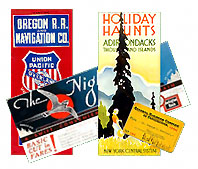 An
immense amount of paper of various kinds was (and is) used by the railroads.
Some examples: public timetables to inform passengers about train schedules,
maps to advertise routes and attract freight business, employee timetables
to inform crews about rules and operations, brochures to entice the
public to tourist destinations served by a particular line, passes
to allow guests and dignitaries free travel on trains, and many other
types of paper. For paper items that were produced for the public, railroad
companies gave a lot of attention to attractiveness and design. Some
companies went so far as to commission artists to paint special artwork
that was then reproduced on timetables, brochures, calendars, and other
items. Even though some of this paper was produced in relatively large
quantities, the fragile nature of paper combined with the tendency of
most people to throw it away after use has resulted in some of it being
rather rare. An
immense amount of paper of various kinds was (and is) used by the railroads.
Some examples: public timetables to inform passengers about train schedules,
maps to advertise routes and attract freight business, employee timetables
to inform crews about rules and operations, brochures to entice the
public to tourist destinations served by a particular line, passes
to allow guests and dignitaries free travel on trains, and many other
types of paper. For paper items that were produced for the public, railroad
companies gave a lot of attention to attractiveness and design. Some
companies went so far as to commission artists to paint special artwork
that was then reproduced on timetables, brochures, calendars, and other
items. Even though some of this paper was produced in relatively large
quantities, the fragile nature of paper combined with the tendency of
most people to throw it away after use has resulted in some of it being
rather rare.
Today, many collectors seek out this paper, some specializing in particular
types such as timetables or passes. They appreciate it as an means of
understanding how railroads operated many years ago, as a window on
travel before the age of commercial aircraft, or as artistic examples
of early public relations. In fact, railroad paper seems to have recently "come
of age" as a collectible, and rare examples have begun to command
impressive prices at auction. Still, more common examples of railroad
paper remain one of the least expensive types of railroadiana, and many
collectors have gotten their start in the hobby with paper.
Locks and Keys
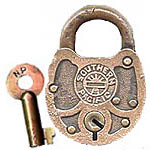 From
the first days of railroad operations, safety and security have been
closely tied together. A misaligned switch or vandalized signal could
have catastrophic consequences, so railroad companies have used locks
of many kinds to secure their physical plants. Some collectors specialize
in collecting railroad locks and keys, particularly ones that carry
a railroad marking. Their interest is due to at least two main reasons.
For one, since security has always been an operational issue for railroads,
many locks and keys date back well into the last century and carry markings
that have great historical meaning. Second, early locks were made of
brass to resist corrosion and often had ornate, sometimes even beautiful,
castings of railroad names to identify ownership. These are sometimes
called "castbacks" or "fancy back locks." Later
on, railroads switched to locks of plainer design, usually made of steel.
These are less sought after than the earlier brass examples but are
still of interest to collectors. From
the first days of railroad operations, safety and security have been
closely tied together. A misaligned switch or vandalized signal could
have catastrophic consequences, so railroad companies have used locks
of many kinds to secure their physical plants. Some collectors specialize
in collecting railroad locks and keys, particularly ones that carry
a railroad marking. Their interest is due to at least two main reasons.
For one, since security has always been an operational issue for railroads,
many locks and keys date back well into the last century and carry markings
that have great historical meaning. Second, early locks were made of
brass to resist corrosion and often had ornate, sometimes even beautiful,
castings of railroad names to identify ownership. These are sometimes
called "castbacks" or "fancy back locks." Later
on, railroads switched to locks of plainer design, usually made of steel.
These are less sought after than the earlier brass examples but are
still of interest to collectors.
Badges
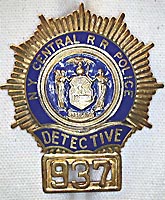 Badges
of many different styles and types were used by railroads. Their purpose
was to both designate authority and indicate employees' jobs. These
functions were especially necessary because of the many different occupational
categories that railroads used as well as the large geographical size
of their territories. Employees who performed the same jobs over perhaps
hundreds of miles needed some way of indicating their authority, and
badges were a major means of doing this. Among the job categories designated
by badges were: engineer, porter, conductor, gateman, station agent,
special agent (police), detective, ticket agent, information clerk,
time clerk, and many more. Badges
of many different styles and types were used by railroads. Their purpose
was to both designate authority and indicate employees' jobs. These
functions were especially necessary because of the many different occupational
categories that railroads used as well as the large geographical size
of their territories. Employees who performed the same jobs over perhaps
hundreds of miles needed some way of indicating their authority, and
badges were a major means of doing this. Among the job categories designated
by badges were: engineer, porter, conductor, gateman, station agent,
special agent (police), detective, ticket agent, information clerk,
time clerk, and many more.
And much more.....
The items described above represent only a fraction of the railroad
memorabilia that collectors search for. Almost everything that was used
in railroad operations (especially if it carries a railroad marking)
is of interest to somebody.
Note. At least one railroad artifacts site has plagiarized this page without permission. All the text shown here is original.
|
|